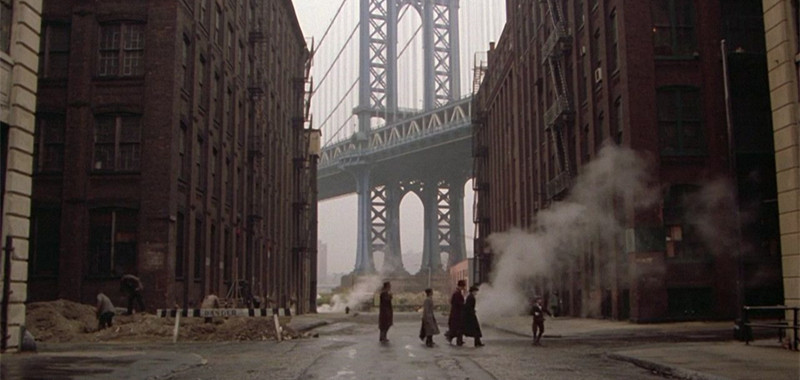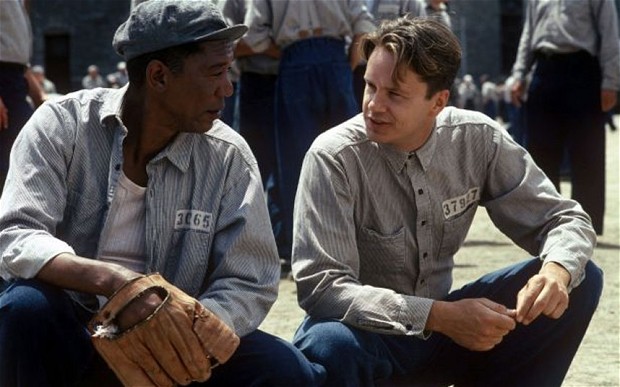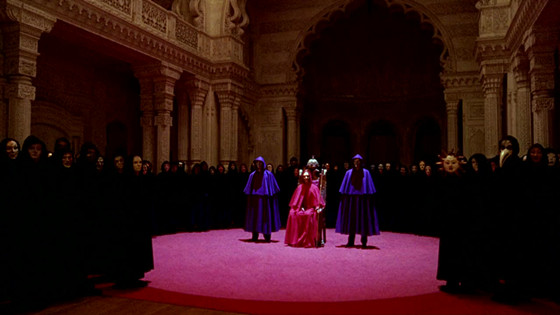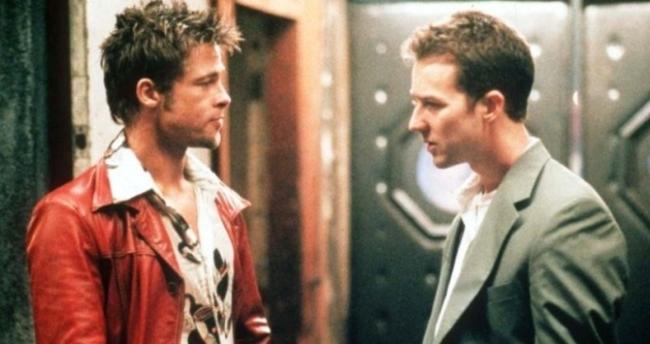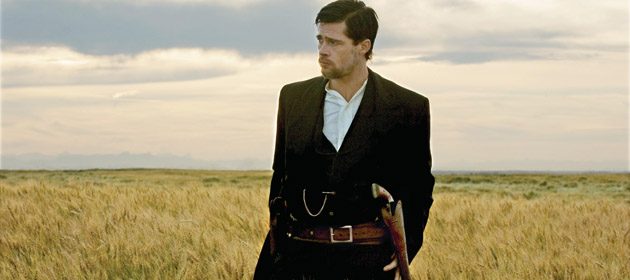14. Once Upon a Time in America (1984)
This is a tough movie. Its four hour running time might seem a struggle for some; the pacing crawls at snail’s pace and the misogynistic undertones are unsettling. Yet, very few films capture one man’s tragic existence in a more elegant and sophisticated manner. Like Last Year at Marienbad and Tree of Life, this is about a man filled with nostalgia and regret reminiscing over his life.
Famously, the studio basically butchered the film for its theatrical release, editing out approximately 2 hours. Even though that left it at a very respectable length for theatrical feature, it ruined the movie, making it completely nonsensical. It would would not be until years later that the four hour cut would finally get its proper debut, and even as recently as 2014, new footage has been discovered and reinserted into the film.
Once Upon a Time in America is Leone’s magnum opus and sits alongside his spaghetti westerns nicely. Many fans still debate the mysteries in the film. Does the ambiguous ending really happen or is it a dream in the opium den? The poster-image of the iconic bridge represents the transition between boyhood and man, innocence and corruption, the gangster and the politician, the birth of America and the decay. Ten years in the making, Leone’s final masterpiece remains his greatest achievement.
15. Brazil (1985)
Brazil – the jewel in Terry Gilliam’s crown. Inspired by George Orwell’s famous novel 1984, Brazil is a satirically bizarre film which epitomizes dystopian science-fiction. Think Monty Python meets Blade Runner. Dystopia is the opposite of Utopia – a paradise, a perfect world. Therefore, think of dystopia as a world falling apart.
Terry Gilliam’s Brazil is the perfect example. Technology is failing us. In fact, Gilliam contrasts the “broken” real world with the dream world of our main protagonist Sam. Sam is at bliss when he is dreaming, happily drifting in a utopian dream world but is always woken harshly to a bitter reality. Masterpieces of any sort are often torturous when one is working on them and Brazil was no exception. It is no secret that he butted heads with the studio to get his vision across.
Audiences didn’t help since many simply didn’t get it. Despite the subversive and quite disturbing story, gruesome imagery, the visuals and art direction are unquestionably stupendous. Once audiences became more accustomed to avant-garde filmmaking, they lauded it with praise, calling it a truly brilliant and hilarious satire.
These days, Brazil has become one the most influential sci-fi films ever made and its quirky and dark Monty Pythonesque sense of humor can be seen on many latter filmmakers’ works, including the Coen brothers. Gilliam has never made such a visually impressive masterwork showcasing such an uncompromising vision since. The production design, FX and visuals are flabbergasting and the film only seems to get better with time. Simply put: dystopian sci-fi has rarely seen better.
16. The Shawshank Redemption (1994)
Believe it or not, this fan favorite was criminally under-seen upon its release in 1994 – perhaps because of its strange title and prison subject matter. Its reputation grew, however, and continued to gain a fan-base. Director Frank Darabont scored a major success with this crowd-pleasing adaptation of Stephen King’s novella.
It is remarkable how many viewers this film connects with. The story is heart-warming, suspenseful, with powerful characters and a hugely influential voice-over by Morgan Freeman. Most surprisingly, this was Darabont’s directorial debut. Previously, he had written scripts for both Nightmare On Elm Street 3 and The Blob – two successful horror films. The studio decided to give him a chance, guessing he’d be a good fit for legendary horror writer Stephen King.
The theme is ‘never give up on Hope.’ As a side note, a much later collaboration between Darabont and King also has a “never give up hope” message – The Mist. Whereas, Shawshank had an uplifting ending, The Mist has a tragic one. Both of which were changed from the original source material. Shawshank Redemption’s active protagonist is Tim Robbins. It opens with him and ends with him and he’s the one that does everything, however, the story is told from his best friend’s point of view, played by Morgan Freeman. This was smart storytelling choice.
As a result, Shawshank has grown among viewers to the point where it remains the highest rated film on IMDB.
17. Crash (1996)
Not to be confused with Paul Haggis’ Crash which won the Academy Award for best picture in 2006, we are referring to David Cronenberg’s Crash, released 10 years earlier in 1996. The Cannes Film Festival awarded the film for its provocative and controversial subject matter but the majority of audiences of the time were simply left baffled.
Interestingly, however, a decade later Total Film polled their readers on what the top 100 greatest movies of all time were and Cronenberg’s Crash made it into the top twenty, at #19. In comparison, Paul Haggis’ Crash which had been instantly accessible by majority audiences, already felt a little dated. Why is this? To quote director Jan Svankmeyer when speaking about Picasso, “Any image grasped too quickly will not leave a lasting impression, but to lead the eye through incomprehension and then to offer a resolution, that is insight.”
What does that mean? Well, sometimes films that use an allegorical approach end up aging far better than films that spoon-feed their message to audiences. Crash is an extreme example of visual storytelling. The subtext throughout lends itself more easily to painting or music. Speaking of which, Howard Shore’s unique score of strictly electric guitars is an interesting updated approach to scoring strings (think Herrmann’s score to Psycho).
Crash is an experience; a work of art that only gets better with time. Upon first release, critics dismissed the film, stating that any film that has three sex scenes in a row is simply pornography. Cronenberg’s no-holds-barred response was asking something along the lines of, “But what sort of sex are they having?” He wasn’t trying to be cheeky, he was taking an analytical approach to sexuality on screen.
Ironically, when Martin Scorsese was questioned on what frontiers of cinema did we still have left to explore in 21st century cinema, his answer was twofold: the human psyche and sexuality. Judging by this, Cronenberg was ahead of his time and, like Stanley Kubrick, he obsessively explores these two subjects through the brilliant use of metaphors.
Released only five years before the start of a new millennium, Crash analyzes us as a species and deliberates on the future of humanity. Mankind has come a long way in the last century – over the last one-hundred years, we have developed advanced technologies that have connected the world in unimaginable ways as well as made us very reliant on computers for both work and play. We create online personalities in avatars and have made social network sites extensions of ourselves.
Could these be the first stages or our turning into cyborgs – a joining of man and machine? This thought perfectly suits Cronenberg’s whimsy and infatuation with “new flesh,” ie: body horror and transformation. In Crash Cronenberg takes technology (the metaphor he uses is the automobile) and humanity (the metaphor he uses is sex) and he “crashes” them together. The result? An uncompromising, sci-fi-esque look at themes that have only become more relevant with time. Cronenberg is indisputably Canada’s finest filmmaker.
18. Eyes Wide Shut (1999)
If there was one director who was consistently ahead of his time, it would have to be Stanley Kubrick. A visionary, Kubrick’s canon of work is a kaleidoscope of styles, themes and genres. From 2001: A Space Odyssey to The Shining, most of his films received poor reviews until critics finally managed to catch up with them ten years later – intellectually speaking of course. At this point, the once-shunned movies shifted to the classics pile and joined the ranks of greatest films ever made.
Eyes Wide Shut is no exception. It is definitive Kubrick: eerie, unsettling, hypnotic and completely original. Surprisingly, Paths of Glory (1957) is the only Kubrick film to be instantly and universally acclaimed upon its release. Coincidentally, that was the last time Kubrick ever did an interview. He remained silent whether his movies were being applauded or damned.
He let the work speak for itself. Human psyche and sexuality – two frontiers that we still have a long way to explore in cinema. From Hitchcock’s Vertigo to David Fincher’s Gone Girl, it is a provocative and complex hot topic. Eyes Wide Shut explores the difficulties in maintaining a marriage. From dangerous temptations to paranoid fear of infidelity, Kubrick covers the entire human psyche.
The film also received much controversy. Warner Brothers felt the orgy sequence was too extreme and the film was going to get an NC-17 rating. Yet, Kubrick’s contract stated that he would get final cut but he sadly passed away before the film’s release, six days after delivering the final cut to Warner Bros. Legally, Warner could not cut anything out, so they came up with another solution; they created CGI extra characters and used them to block some of the more explicit scenes. Warner didn’t get it: Kubrick’s intention was to capture excess and a decadent Romanesque quality (very Fellini).
Censoring the scene created a voyeuristic, taboo-like scenario. Thankfully, however, the film was released untouched in Europe, highlighting the differences between European and North American censorships. Thankfully, the current Blu-Ray release is the uncensored version.
Much has been written about the casting of Tom Cruise and Nicole Kidman. Some were put off by seeing these two famous Hollywood stars (married to each other at the time) in a Kubrick film. But like the unusual casting in The Shining, it was a genius decision. Kidman and especially Cruise tend to come across as if they are covered in an artificial gloss. They are decent actors but, when compared to actors like Daniel Day Lewis or Robert De Niro, their public appearances seem slightly contrived and hollow.
Kubrick used this to the advantage of the film. Kidman and Cruise seem to be real but, in actuality, there’s a falsity in their appearance. Their eyes literally are wide shut. It may not have been the biggest surprise that, after an intense shooting period which lasted over a year – unheard of in Hollywood! – these two big stars would divorce.
The film actually holds the Guinness World Record for the longest continuous film shoot period, at 400 days. (To get an idea of how obsessive Kubrick was, the brief billiard scene with Cruise and Sydney Pollack took two weeks to shoot.) The complexity of the film is also mirrored with ambiguity. Like Vertigo or Gone Girl, we’re never sure just how much of what we’re seeing is real. Are characters (and the audience) being lied to? It is set in New York but it doesn’t quite look like New York but rather something stranger and surreal.
In fact, as Scorsese once stated, the streets don’t even exist. Kubrick is creating yet again a heightened sense of reality. Like his best work, one is not meant to take things so literally. Sometimes an expressionistic approach can reach a greater truth about ourselves. Today, it seems we’re still trying to catch up with the brilliance of Eyes Wide Shut.
The use of music, imagery and actors all help create a world that would be the final experience Kubrick would leave us with. Reportedly, he confided in Pollack that he felt it was his best work (Kubrick was famously critical of his own films). It seems he wasn’t the only fan of the film though. Martin Scorsese voted it the fourth best film of the decade.
19. Fight Club (1999)
Fight Club is a modern cult classic starring mega-star Brad Pitt. If you can get past the violence, it’s actually a supremely intelligent film and epitomizes late 90’s cinema. During this period, there was a preoccupation with trying to say something truthful and honest in a very urgent way. Even in Hollywood, you had numerous films coming out that tapped into the theme of the millennium: wake up to the world around you.
As our global communication becomes more advanced with each coming year, there’s a tendency to break down barriers and see our planet as one. On the brink of 2000, there was a Y2K scare and a feeling of the coming of an apocalypse. Many filmmakers told stories that were about waking up before it’s too late: The Matrix, American Beauty, Magnolia and The Sixth Sense to name a few.
In Fight Club, Edward Norton’s character is “asleep” at the beginning of the film, or rather ironically, he literally can not fall asleep. He’s part of the conformity of the rat race – an advertisement for Ikea. Eventually, he has to wake up to his true inner self. The catalyst is the creation of the Fight Club which represents anti-conformity. A clear way to sum up the theme of the millennium is this: searching for God in a world of science. As Tyler Durden states at one point, “Our great war is a spiritual war. Our great depression is our lives.”
In Fight Club, the creative approach or metaphor they use to express this theme, is one of the male identity. You have women in the workplace, you have fathers staying at home, raising the kids, and you even have sexual identities under transition. What’s male and what’s female isn’t as black and white anymore. So, what role do men play in society today? Edward Norton’s character is “in pain” as he tells his doctor. He desires or drugs to become even more sedated. Yet, he’s instructed to attend support groups to become enlightened.
One of which is clearly labeled, “Remaining Men Together.” “We’re still men?” he asks the giant man with breasts in front of him. Then, with his face buried in the man’s chest, he finds his answer. We hear gospel music on the soundtrack. He breaks down in tears and relief. He pulls back and we see the Shroud of Turin – the face of Christ. He’s healed and now he can finally sleep.
The film is about taking a step back, re-evaluating where we are, and find some kind of meaning. The “fight club” itself is a catalyst for the new male identity to wake up. We’re not supposed to take the club literally. It’s a metaphor.
Fight Club is ultimately a slick art film disguised as a Hollywood movie. Both American Beauty and Fight Club came out in 1999. American Beauty received instant recognition. Whereas, Fight Club’s more metaphorical approach would take audiences a few years to catch up with. These days, its reputation has aged better than American Beauty. It seems the cult following of Fight Club is greater now than ever before.
20. The Assassination of Jesse James by the Coward Robert Ford (2007)
Australian filmmaker Andrew Dominik made a beautiful moving painting to guide us through a tale of hero worship and obsessed fanaticism.
A revisionist western as profound as Robert Altman’s McCabe & Mrs. Miller, the exquisite beauty of the cinematography and score is spellbinding. The cast is impeccable, in particular Casey Affleck’s painfully awkward and restrained performance as Robert Ford. The voice-over recalls Terrence Malick and the languid story structure is free from cliches and is utterly poetic. The score is also composed by famed rock star Nick Cave (who, incidentally, wrote his own brilliant Australian western called The Proposition).
The Assassination of Jesse James is a contemporary underrated masterpiece. It is reflective, visually sumptuous and thought-provoking; this period piece is particularly relevant today amidst our celebrity worship. (There is a rumored four-hour director’s cut that is highly anticipated). Being the most recent film on this list, we will undoubtedly be catching up with this masterwork in years to come.
Author Bio: A six-time “Instructor of the Year” and “Best Course” winner at Vancouver Film School, Paul’s commitment and passion for cinema and the visual arts has labeled him a ‘walking encyclopedia’ of classic, modern, Hollywood, and international cinema. He also teaches Screenwriting and Canadian Cinema at Langara College in Vancouver, as well as hosting Screenwriting workshops and Film Nights at independent venues, including The Vancouver Club.
